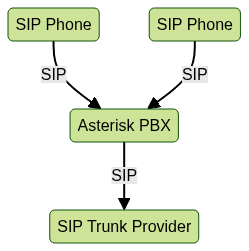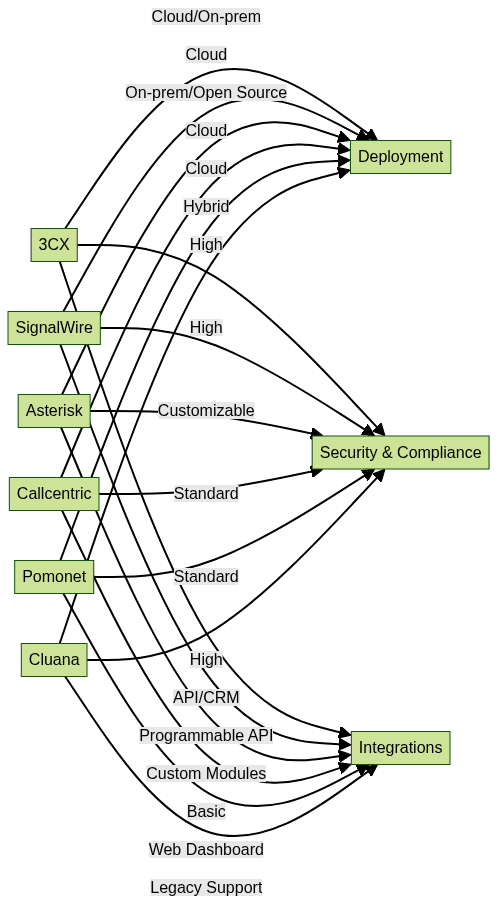Introduction
As businesses embrace digital transformation, the need for robust, flexible, and secure business phone systems has never been greater. VoIP Innovations has served as a notable provider in the industry, but organizations often seek alternatives for reasons ranging from pricing and feature set to support and compliance. In this comprehensive guide, we explore the top VoIP Innovations alternatives available in 2025. Whether you're planning a migration or just starting your research, understanding the full landscape of VoIP options will help you make an informed decision tailored to your business needs.
Why Consider VoIP Innovations Alternatives?
There are several drivers behind the search for VoIP Innovations alternatives. Organizations may require more competitive pricing models, advanced features, or enhanced customer support. Regulatory compliance (such as GDPR or HIPAA), reliability, or a need for custom integrations can also prompt the exploration of business phone system alternatives. The VoIP space is rapidly evolving, with innovations in cloud telephony, AI-powered analytics, and programmable APIs reshaping what's possible for business communications. In 2025, companies expect their telephony solutions to offer seamless migration, robust security, and the agility to support remote and hybrid teams. By evaluating VoIP Innovations alternatives, businesses can find platforms that better align with their growth, technical, and compliance requirements. If your business is looking for advanced integration, consider exploring a
phone call api
to enhance your communication stack.Top VoIP Innovations Alternatives
3CX (Cloud & On-premise PBX)
3CX stands out as a versatile PBX solution supporting both cloud and on-premise deployments. It offers a feature-rich environment with video conferencing, mobile apps, web client, and contact center features. Pricing is transparent, available as a subscription per system rather than per user, making it cost-effective for SMBs and larger organizations. For teams interested in adding video capabilities, integrating a
Video Calling API
can further extend 3CX's communication features.Pros:
- Flexible deployment (cloud, on-premise, hybrid)
- Advanced call routing, IVR, and CRM integration
- Strong developer API for automation and customization
Cons:
- Advanced features may require higher-tier licenses
- On-premise setup can be complex for smaller teams
Use Case: Basic PBX Automation with 3CX API
1import requests
2
3API_URL = "https://your-3cx-server/api/CallControl"
4API_KEY = "YOUR_3CX_API_KEY"
5
6payload = {
7 "action": "create_call",
8 "from": "+12065551234",
9 "to": "+12065557654"
10}
11headers = {
12 "Content-Type": "application/json",
13 "Authorization": f"Bearer {API_KEY}"
14}
15
16response = requests.post(API_URL, json=payload, headers=headers)
17print(response.json())
18SignalWire (Programmable Communications)
SignalWire delivers a cloud-native communications platform with programmable voice, messaging, and video APIs. Its developer-first approach, real-time AI integration, and elastic scalability make it a favorite among startups and tech-focused enterprises. If you’re looking to embed audio calling into your applications, SignalWire is compatible with leading
phone call api
solutions for seamless integration.Pros:
- Rich API ecosystem with JavaScript, Python, and REST support
- AI transcription, speech analytics, and call routing
- Pay-as-you-go pricing with global reach
Cons:
- May require developer resources for full customization
- Fewer out-of-the-box PBX features compared to traditional platforms
Example: Setting Up a Voice Call with SignalWire API
1const signalwire = require('@signalwire/node')
2
3const client = new signalwire.RestClient({
4 project: 'your_project_id',
5 token: 'your_api_token'
6});
7
8client.calls.create({
9 from: '+12065551234',
10 to: '+12065557654',
11 url: 'https://yourapp.com/answer'
12}).then(call => console.log(call.sid));
13Asterisk (Open Source PBX)
Asterisk is the world’s leading open-source framework for building communications applications. It is highly customizable, with a vast community and extensive documentation, making it ideal for organizations with in-house technical expertise. Developers can leverage
Voice SDK
tools to build scalable audio solutions on top of Asterisk, enabling advanced use cases such as live audio rooms and interactive voice features.Pros:
- Completely open source and free to use
- Extensive customization for PBX, IVR, and call centers
- Huge ecosystem and community support
Cons:
- Steep learning curve for setup and management
- Requires server hosting and ongoing maintenance
Use Case: Integrating Asterisk with SIP Trunking

Callcentric (VoIP for SMB and Residential)
Callcentric provides flexible VoIP solutions tailored for SMBs and residential users. With a range of pay-as-you-go and unlimited plans, Callcentric is known for its ease of setup, strong support, and number portability features. If you’re developing a VoIP call app for iOS, following a
callkit tutorial
can help you integrate native call management features for a seamless user experience.Pros:
- Simple setup and management via web portal
- Competitive pricing with a-la-carte options
- Number porting and E911 support
Cons:
- Limited advanced PBX features for large enterprises
- Some integrations require manual configuration
Pomonet (Cloud Business Telephony)
Pomonet is designed for businesses seeking plug-and-play cloud telephony. Its focus on ease of use, cost-efficiency, and mobile-first features make it well-suited for remote and distributed teams. For companies looking to quickly
embed video calling sdk
into their workflow, Pomonet’s cloud architecture makes integration fast and straightforward.Pros:
- Cloud-based with zero hardware required
- Intuitive web dashboard
- Mobility and remote work features
Cons:
- Less customizable than open-source or programmable platforms
- Limited on-premise or analog hardware integration
Cluana (Hybrid Analog/IP & Hosted PBX)
Cluana bridges the gap between legacy analog/ISDN setups and modern IP telephony. Its hybrid PBX supports on-premise hardware, hosted services, and seamless migration paths. Businesses with hybrid needs can benefit from integrating a
phone call api
to unify analog and digital communications under a single programmable interface.Pros:
- Analog and digital trunk compatibility
- Hardware integration for legacy systems
- Flexible cloud and on-premise deployment
Cons:
- May require specialized hardware for hybrid deployments
- Complexity in large-scale migrations
Feature Comparison Table
Here’s a feature matrix comparing the top VoIP Innovations alternatives. Use this as a quick reference to identify which platform aligns best with your business priorities. For organizations requiring both audio and video conferencing, integrating a
Video Calling API
can provide a unified solution across platforms.
| Platform | Pricing Model | Deployment | Integrations | Security & Compliance | Analog/IP Support |
|---|---|---|---|---|---|
| 3CX | Per system | Cloud/On-prem | CRM, API | High | Yes |
| SignalWire | Pay-as-you-go | Cloud | API, AI, Webhook | High | No |
| Asterisk | Open source | On-prem | Custom modules | Customizable | Yes |
| Callcentric | Per feature/user | Cloud | Basic | Standard | Limited |
| Pomonet | Subscription | Cloud | Web dashboard | Standard | No |
| Cluana | Hybrid/Custom | Hybrid | Legacy, API | High | Yes |
Key Considerations When Choosing a VoIP Innovations Alternative
When evaluating VoIP Innovations alternatives, focus on these critical factors:
- Deployment Options: Decide between cloud, on-premise, or hybrid solutions. Cloud PBX offers flexibility and lower overhead, while on-premise PBX can provide greater control and security.
- Security & Compliance: Ensure the platform meets your regulatory needs (GDPR, HIPAA, PCI-DSS) and has strong encryption, authentication, and data retention policies.
- Scalability & Flexibility: Choose a solution that can grow with your team. Look for elastic licensing, multi-site support, and remote work features.
- Cost Structure: Compare flat-rate, per-user, and pay-as-you-go pricing models. Factor in hidden costs, such as setup fees, number porting, or premium features.
- Migration & Support: Assess the vendor’s migration tools, documentation, and customer support. Seamless data transfer, downtime minimization, and robust onboarding resources are essential for a smooth transition. If you’re building a custom iOS call solution, a
callkit tutorial
can be invaluable for integrating native call functionality.
Migration Strategies: Moving from VoIP Innovations
Switching from VoIP Innovations to a new provider requires careful planning. Begin by auditing your current setup: list all phone numbers, extensions, call routes, and integrations. Back up all relevant data and configurations. For developers, leveraging a
phone call api
can simplify the migration of call flows and integrations to your new platform.Steps for a Smooth Migration:
- Data & Number Porting: Coordinate with your new provider for number porting and configuration imports.
- Minimal Downtime: Schedule cutovers during off-peak hours and use temporary call forwarding if needed.
- Configuration Testing: Validate all call flows, IVR, and endpoints before going live.
- Training: Provide documentation or training sessions for end-users to minimize confusion.
- Support: Ensure you have access to vendor or community support during and after the migration.
Migration Checklist:
- Inventory all numbers/users
- Export settings and call flows
- Back up voicemails and recordings
- Test porting and call routing
- Prepare user guides and training
Advanced Features to Look For
Modern VoIP Innovations alternatives deliver far more than basic telephony. Consider platforms that offer:
- AI-powered analytics: Real-time transcription, sentiment analysis, and automated reporting for deeper business insights.
- Integration with legacy systems: Compatibility with SIP trunks, analog devices, and proprietary PBX hardware.
- Programmable APIs: Developer access for building custom call flows, chatbots, or CRM integrations. Utilizing a
Voice SDK
can enable advanced audio features, while aphone call api
allows for seamless voice integration. - Mobility & remote work: Native mobile apps, softphones, and browser-based calling for distributed teams.
- Advanced communications: Voicemail-to-email, automated call routing, conferencing, SMS, and omnichannel chatbots.
These features can dramatically improve productivity, customer experience, and IT agility in 2025 and beyond.
Conclusion: Choosing the Best VoIP Innovations Alternative
Selecting the best VoIP Innovations alternative hinges on your business’s unique needs—whether it’s scalability, security, migration ease, or advanced features. Review the comparison table, evaluate your requirements, and take advantage of free trials or demos before making a decision. The right VoIP platform will empower your communications today and support your growth into the future. Ready to explore the next generation of business communications?
Try it for free
and experience the difference firsthand.Want to level-up your learning? Subscribe now
Subscribe to our newsletter for more tech based insights
FAQ